Auckland Rail Leaps 21%
Rail patronage has leaped 21.5% on the figures a year ago.
Overall public transport patronage has leaped 8.4%.
The Northern Express bus service continues to be an incredible story - 15.4% growth in a year.
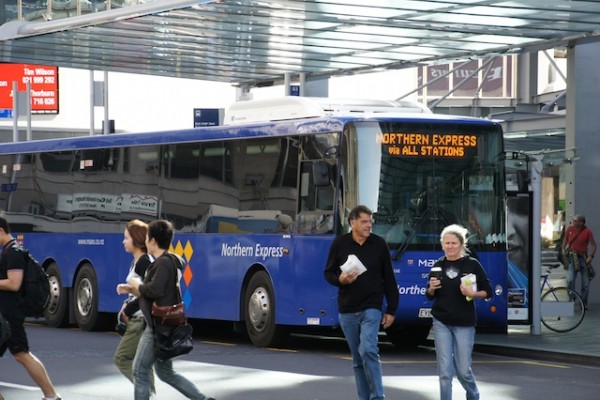
Auckland public transport patronage totalled 65,371,759 passengers for the 12-months to May 2011 an increase of 5,062,687 boardings or +8.4%.
Here’s a breakdown of patronage by month, 12-months rolling total and financial year-to-date (July 2010 to May 2011). For the financial year-to-date, eleven months to May 2011, patronage has grown by +8.6% (4,749,466 boardings). Patronage for May 2011 was 6,333,297 boardings, an increase of
+10.3% (590,333 boardings) on May 2010.
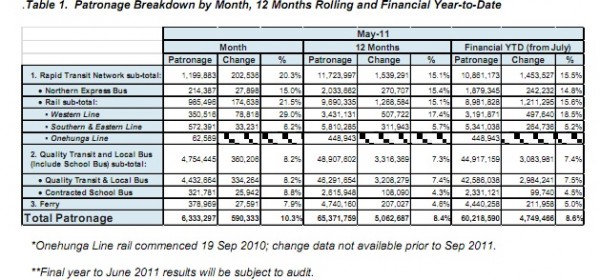
Rail patronage totalled 9,690,335 passengers for the 12-months to May 2011 an increase of 1,268,584 boardings or +15.1%.
For the financial year-to-date, eleven months to May 2011, patronage has grown by +15.6% (1,211,295 boardings)
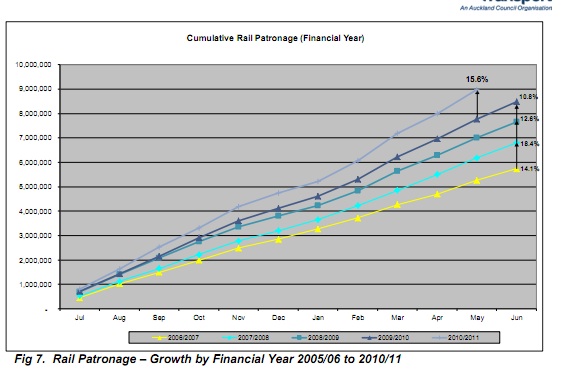
Patronage for May 2011 was 985,496 boardings, an increase of +21.5% (174,638 boardings) on May 2010 . Note that there was one additional business day in May this year compared to the same day last year.
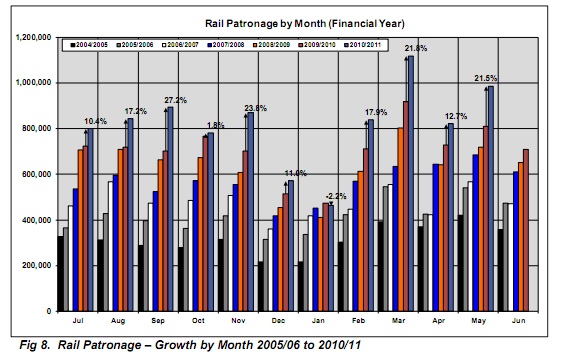
Southern and Eastern Line rail patronage including the Onehunga Line totalled 6,259,228 passengers for the 12-months to May 2011 an increase of 760,886 boardings or +13.8%.
For the financial year-to-date, eleven months to May 2011, patronage has grown by +14.1% (713,679 boardings). Patronage for May 2011 was 634,980 boardings, an increase of +17.8% (95,820 boardings) on May 2010 .
In May 2011 there were 572,391 passengers recorded travelling on the Southern and Eastern Lines excluding the Onehunga Line, an increase of +6.2% on May 2010.
There were 62,589 passengers recorded using the Onehunga Line during May 2011. For the year-to-date since the inception of these services in September 2010 there have been 448,943 passengers recorded on Onehunga Line services - a line people like Mike Lee had to fight hard to convince certain people it would work!
Western Line rail patronage totalled 3,431,131 passengers for the 12-months to May 2011 an increase of 507,722 boardings or +17.4%. For the financial year-to-date, eleven months to May 2011, patronage has grown by +18.5% (497,640 boardings).
Patronage for May 2011 was 350,516 boardings, an increase of +29.0% (78,818 boardings) on May 2010.
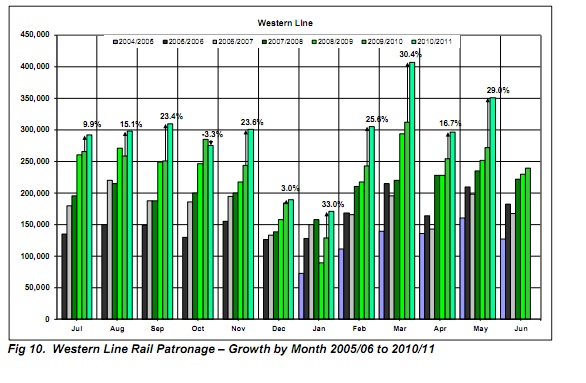
The Northern Busway along with the rail network forms the Rapid Transit Network. Northern Express patronage totalled 2,033,662 passengers for the 12-months to May 2011. That’s an increase of 270,707 boardings or +15.4%.
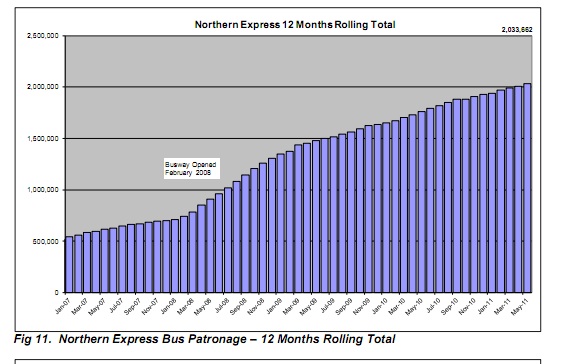
For the financial year-to-date, eleven months to May 2011, patronage has grown by +14.8% (242,232 boardings)

Patronage for May 2011 was 214,387 boardings, an increase of +15.0% (27,898 boardings) on May 2010.
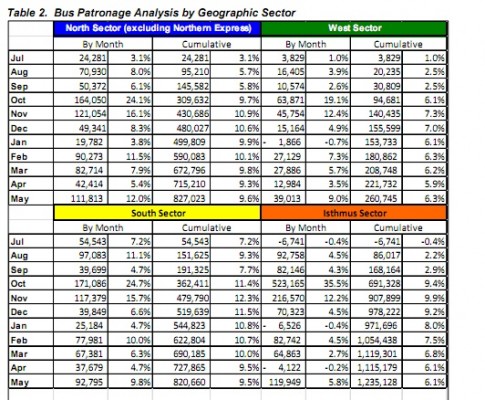
Ferry patronage totalled 4,740,160 passengers for the 12-months to May 2011 an increase of 207,027 boardings or +4.6%.
For the financial year-to-date, eleven months to May 2011, patronage has grown by +5.0% (211,958 boardings). Patronage for May 2011 was 378,969
boardings, an increase of +7.9% (27,591 boardings) on May 2010 .

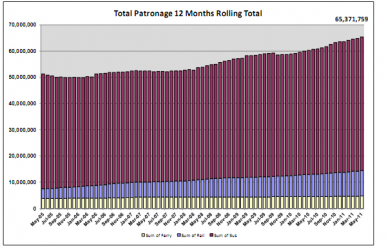
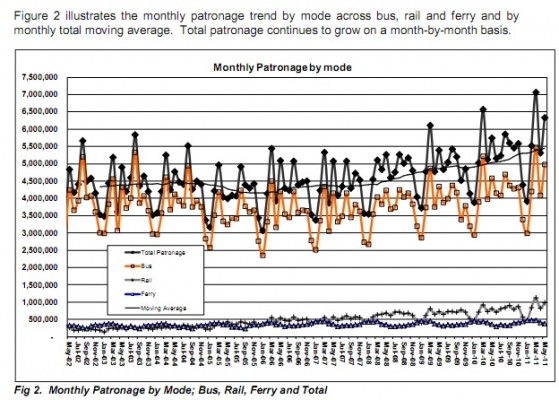
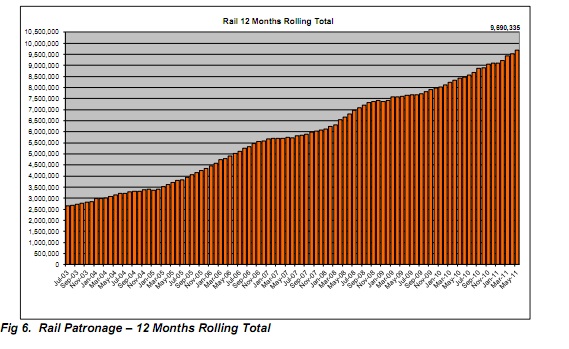
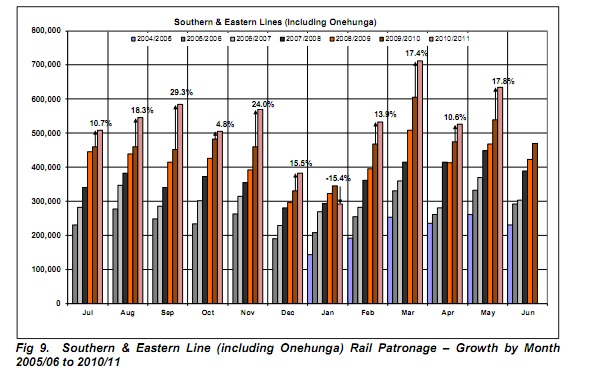










20 Comments
Are improvements to 1990′s like weekend timetable on the Western line likely in the near future?
What’s particularly impressive is that the growth has been maintained despite petrol prices decreasing from their peak.
As it’s looking likely that prices will drop back below $2 in the near future, it will be interesting to see if that psychological barrier is as significant in terms of PT use as has been assumed.
Kurt - The rumor is weekends will be improved in Feb at the same time as Manukau opens and we get 10 min frequencies out west.
Why can’t they improve weekend services now?! They’re worthless at present, and we’re about to be inundated with tourists who’ll be expecting weekend services to be actually useful.
@Matt February. It would be great if they could introduce lots of improvements now - the poor weekend schedules drive me nuts and drive me back to the car- but it’s not that easy.
So the Northern Busway now has close to as many people using it as our entire rail network had when Britomart opened. Great progress.
Looks like it will not be long until rail patronage reaches 10 million for twelve months. Imagine what growth would be like, if as has been suggested we actually get decent weekend frequencies. The momentum just does not look like stopping,
Matt - AT have pretty much already spent or committed all the money allocated to them for PT services for this year. As such at the last timetable change they focused the spending on the areas they feel will give the biggest bang for buck, up to now that has mainly been improving peak and shoulder peak services.
Good results but I would like to know some really uesful financially sustainable stuff that will convince payers/funders we are getting better value for money each month. For example with the increase in patronage is the subsidy per passenger for Auckland Passenger Rail falling? Or is the farebox recovery % per passenger rising. It is easy enough to “buy” passenger ridership increases but is Auckland Passenger Rail financially doing any better? Is it improving? It has been appalling compared to Wellington on a cost per passenger basis due to a very high operating cost structure in Auckland Metro Rail. A key metric should be to show this cost falling per passenger - not just patronage on its own - which is only one side of the propoganda coin. Has this improved??
We need to demonstrate financial improvements too in order to convince officials for money to be invested and so grow things like weekend services.
@Giel the issue with rail and farebox recovery is it is all about sudden ups and downs.
If patronage has grown substantially without an increase in service then of course the farebox recovery has gone up, however commuters are jammed in trains so its not good for positivefeelings about rail.
As soon as we start 30min weekend services the farebox recovery will drop substantially. But Auckland Transport need to be taking a long term view, and showing that rail is the way of the future.
Giel, Wellington has the advantage of electric trains, which are cheaper to operate, and generous gifts from central government to purchase rolling stock. Make sure you’re comparing apples with apples before deciding that Auckland rail is a basket case if contrasted with Wellington.
If only we had a Western Express and Eastern Express. Both of those are far more important than spending a trillion dollars tacking on another 100 lanes of motorway in every direction.
Giel, what’s the farebox recovery for cars and trucks?
If patronage has grown substantially without an increase in service then of course the farebox recovery has gone up, however commuters are jammed in trains so its not good for positivefeelings about rail.
Indeed. Because in NZ it’s usually all about delivering a particular metric - not about whether people actually have pleasant experiences. Unless it’s cars, and then the metric of time-savings, which is also about improving experiences and reducing frustration, is applied.
Geil – ARTA used to include the amount of money spent on the rail contract for both the month and year to date in their monthly reports but that is not included now that AT has taken over so it makes things a bit more difficult. The last timetable change was halfway through September last year saw a lot more services added including the opening of Onehunga. That is also the last month that we saw an ARTA report so we can’t really use old reports to make some guesses.
Also apart for increased services there are other things that will be impacting on cost per passenger, of the big ones will be that track access charges have dramatically increased.
You could do an OIA request to find out the exact figures.
“If patronage has grown substantially without an increase in service then of course the farebox recovery has gone up, however commuters are jammed in trains so it’s not good for positive feelings about rail” and
“Because in NZ it’s usually all about delivering a particular metric – not about whether people actually have pleasant experiences. Unless it’s cars, and then the metric of time-savings, which is also about improving experiences and reducing frustration, is applied.”
Sure externalities need to be taken into account but I ask again what is the farebox recovery? It is a very pertinent question and we should demand accountability.
Assumptions that increasing patronage automatically means increased farebox recovery is fundamentally flawed. For example Gold Card users are using trains and PT generally more and more - just because a denominator goes up (passenger numbers) doesn’t mean the numerator (costs) stays constant. Sorry but that is BS with a capital B! What extra costs are being incurred not directly connected to increased frequency of services - more staff about - more people rostered on duty - higher fuel costs for DFT locos, higher track charges from Kiwi Rail due to micro management by them to ensure improved network equipment reliability , higher station maintenance costs, higher Metro Mechanical Maintenance costs due to more breakdowns of equipment . The list goes on. The truth is we don’t know but we should. Extra patronage in Auckland is not falling straight to the bottom line. You need to do proper analysis - I could pull those arguments apart in seconds and so can any official worth their salt. We need real numbers in total not selected propaganda to make things look good.
Ah Electrification - operating costs - are they truely lower? How do you know that? What about much higher capital costs? What is the projected farebox recovery post electrification? Only questions guys. May well improve but we need the targets to measure against to show that. I support electrification but we need the numbers. As I said it is fundamentally flawed to look at Passenger numbers in isolation.
Oh and while I am at it - $1.6 Billion investment so far in Auckland Rail at 6% finance cost pa (generous I know) is about $100 million in finance costs a year for infinity over 10 million passenger journeys pa. That is $10 per passenger journey alone (even the Gold Card and 5 year child passenger ones that go one station stop journey) for just the finance cost of the $1.6 Billion let alone running costs deficits of the network such as maintenance etc, loan amortisation (paying back the principal) and the running costs of one train let alone the 1,000 or so a week we run !!! Come on guys let’s look at the real numbers. If they are good they will support our arguments – if not then we collectively need to ask why not?
For that sort of investment we need 20 to 30 million passengers per year at least or a much higher fare yield.
Matt L – Good thoughtful response as usual.
Guys - Fare box recover for cars close to a 100% (some rate payers subsidy for local roads but nothing much for national network other than some RONS funding). Owners of cars pay the costs through fuel, capital cost, maintenance, license fees etc. Ask any car owner the full life cost of a car – it is very high price for freedom/independence of the car but one most are willing to pay through the nose for! Trucks recovery is about 70% - Rail in Auckland way lower than both of those.
Giel, have you considered that a functional public transport system is a good in its own right, even if it’s not fully self-supporting? There’s more to the return than a straight money in-money out calculation.
We don’t damn the road network for needing taxpayer topups, except when we’re faced with the Minister for Trucks denying public transport funding while pouring billions of dollars into roading.
Geil - here is a post I did a while ago, its shows a breakdown of the costs for rail in auckland as of the middle of last year. It also has some info on what the electrics are expected to cost (annoyingly they blacked out the revised EMU costs in the MOT review)
http://transportblog.co.nz/2011/03/31/just-how-much-will-electric-trains-cost-to-run/
Geil, the costs of auto dependancy are not fully counted, one word: parking. We all have to provide parking whether we drive or not, huge land opportunity costs… Just one example.
Matt L wrote: “As such at the last timetable change they focused the spending on the areas they feel will give the biggest bang for buck”
The new weekend rail timetable out west introduced in September 2010 was just plain stupid. They allocated full funding for an hourly Sunday service to Waitakere, but instead used every cent to provide an extra train on Saturdays that nobody could use. Still hourly, but operated by three trains instead of two, with a massive amount of down time at Waitakere.
We had the train, the crews and the funding for a full Sunday service, and it was wasted. Still is wasted. They could reallocate that third train to Sundays at any time. It would cost absolutely nothing to start Sunday trains to Waitakere.
Biggest bang for buck? No!
Matt - Yes I have considered that PT is good in its own right and that is why I am a stronger supporter, advocate and user of it. I agree with you that is why some subsidy, as you point out, is required for PT as the externality benefits are large and not measured in simple accounting / finance way. It is not so much that but the size of the subsidy per rail passenger journey in Auckland relative to other cities, that concerns me. We just need to hone are arguments right and make sure value for money, as Geoff is alluding to, is also near the top of the list as money will always be tight. Currently I think the value is relatively poor in Auckland (see Matt L’s link on Auckland Transport blog). I guess what I am getting at is that this is sometimes forgotten and that the biggest bang for bucks is important. That is why I think that reporting the financial metrics is important for accountability and stakeholder buy in. It is like reporting sales but not the costs relating to those sales - doesn’t mean much I am afraid. People can always explain shortfall’s by externality benefits but these need verifying as much as possible.
Patrick R - Some might argue that with the high parking costs from the likes of Wilsons etc that is covered by users. Another debate there I am sure.
Matt L - Good summary of yours on Auckland Transport Blog. Looks about right for current costs but I think running/maintenance costs of electrification will be a lot higher than that as a comparative. Keep chugging away and see if you can get better numbers on that one as it would be very useful for a comparison and to also counter the doubters.